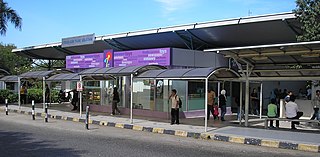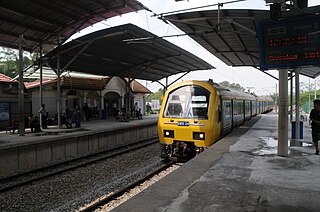Keretapi Tanah Melayu Berhad (KTMB) or Malayan Railway Limited, colloquially referred to simply as KTM, is the main rail operator in Peninsular Malaysia. The railway system dates back to the British colonial era, when it was first built to transport tin. Previously known as the Federated Malay States Railways (FMSR) the Malayan Railway Administration (MRA), and the Malayan Railway, Keretapi Tanah Melayu acquired its current name in 1962. The organisation was corporatised in 1992, but remains wholly owned by the Malaysian government.

The ERL KLIA Transit is a commuter rail service which serves as an airport rail link to the Kuala Lumpur International Airport (KLIA) in Malaysia. It runs from KL Sentral, the main railway station of Kuala Lumpur to KLIA's Terminal 1 and Terminal 2. The line is one of the two services on the Express Rail Link (ERL) system, sharing the same tracks as the KLIA Ekspres. KLIA Transit stops at all stations along the line, whereas KLIA Ekspres runs an express, non-stop service between KL Sentral and the airport. The line is operated by Express Rail Link Sdn. Bhd. (ERL).

KTM Komuter is a commuter rail system in Malaysia operated by Keretapi Tanah Melayu (KTM). It was introduced in 1995 to provide local rail services in Kuala Lumpur and the surrounding Klang Valley suburban areas. Services were later expanded to other parts of Malaysia with the introduction of the Northern and Southern sectors.

The Kuala Lumpur railway station is a railway station located in Kuala Lumpur, Malaysia. Construction began in 1910 and was fully completed in 1917. It replaced an older station on the same site, the station was Kuala Lumpur's railway hub in the city for the Federated Malay States Railways and its successor Keretapi Tanah Melayu, before Kuala Lumpur Sentral assumed much of its role in 2001. The station is notable for its architecture, adopting a mixture of Eastern and Western designs.

The Express Rail Link Sdn Bhd is a company that owns and operates the airport rail link of the same name that connects the Kuala Lumpur International Airport (KLIA) with the Kuala Lumpur Sentral transportation hub, 57 kilometres apart. The company operates two different train services:

Rail transport in Malaysia has evolved significantly since its inception in the late 19th century, reflecting the country's economic growth and modernization.

Bandar Tasik Selatan station (BTS) is a major Malaysian interchange station located next to and named after Bandar Tasik Selatan, in Kuala Lumpur. The station serves as both a stop and an interchange for the KTM Komuter's Seremban Line, KTM ETS, the LRT Sri Petaling Line, and the Express Rail Link's KLIA Transit trains. BTS is integrated with the Terminal Bersepadu Selatan bus hub (TBS). BTS and TBS are developed as an intermodal transportation hub.
Transport in Greater Kuala Lumpur includes a road network, a railway network, airports, and other modes of public transport. Greater Kuala Lumpur is conterminous with the Klang Valley, an urban conglomeration consisting of the city of Kuala Lumpur, as well as surrounding towns and cities in the state of Selangor. The Klang Valley has the country's largest airport, the Kuala Lumpur International Airport (KLIA), as well as the country's largest intermodal transport hub and railway station, Kuala Lumpur Sentral.

The Seremban railway station is a Malaysian railway station located in the heart of Seremban, the capital of the state of Negeri Sembilan. The station is named after the city.

UKM Komuter station is a KTM Komuter train station situated close to and named after the National University of Malaysia (Malay: Universiti Kebangsaan Malaysia, UKM) in Bangi, Hulu Langat District, Selangor, Malaysia.

The Kajang railway station is a Malaysian railway station located near and named after the town of Kajang, Selangor. The station is situated 1 km south of Kajang's town centre. However, the MRT Kajang line is also named after the station as well, since it served as a terminus and the final station for the line.

The Tanjung Malim railway station is a Malaysian train station stationed at the north eastern side of and named after the town of Tanjung Malim, Perak. The station provides both Komuter and ETS services.

The Butterworth railway station is a Malaysian railway station located at and named after the town of Butterworth, Penang.

The Padang Besar railway station is a railway station located at and named after the town of Padang Besar, Perlis in Malaysia which is located at the Malaysia-Thailand border.

The Pulau Sebang/Tampin railway station is a Malaysian train station on the West Coast Line located near and named after the bordering towns of Pulau Sebang, Malacca and Tampin, Negeri Sembilan. The station itself is situated in Malaccan territory, being one of the two stations on the West Coast Line that serves the state of Malacca, the other being Batang Melaka.

Gemas railway station is a Malaysian railway station located at the eastern side of and named after the town of Gemas, Tampin District, Negeri Sembilan. Built in 1922, the station is the meeting point of and the railway junction connecting the West Coast Line with the East Coast Line (Tumpat–Gemas).

The KTM ETS, commercially known as ETS, is an inter-city higher-speed rail service in Malaysia operated by Keretapi Tanah Melayu (KTM). The KTM ETS is the second electric train service to be operated by the Malaysian railway company after KTM Komuter, and the second inter-city rail service after KTM Intercity.

Johor Bahru Sentral is an integrated transport hub in Bukit Chagar, Johor Bahru, Johor, Malaysia.

The Klang Valley Integrated Transit System is an integrated transport network that primarily serves the area of Klang Valley and Greater Kuala Lumpur. The system commenced operations in August 1995 with the introduction of commuter rail service on the existing rail between Kuala Lumpur and Rawang. The system have since expanded and currently consists of 11 fully operating rail lines in a radial formation; two commuter rail lines, six rapid transit lines, one bus rapid transit line and two airport rail links to the Kuala Lumpur International Airport's (KLIA) Terminal 1 and Terminal 2, and one temperarily suspended airport rail link to the Sultan Abdul Aziz Shah Airport. The system encompasses 528.4 kilometres (328.3 mi) of grade-separated railway with 197 operational stations.

















